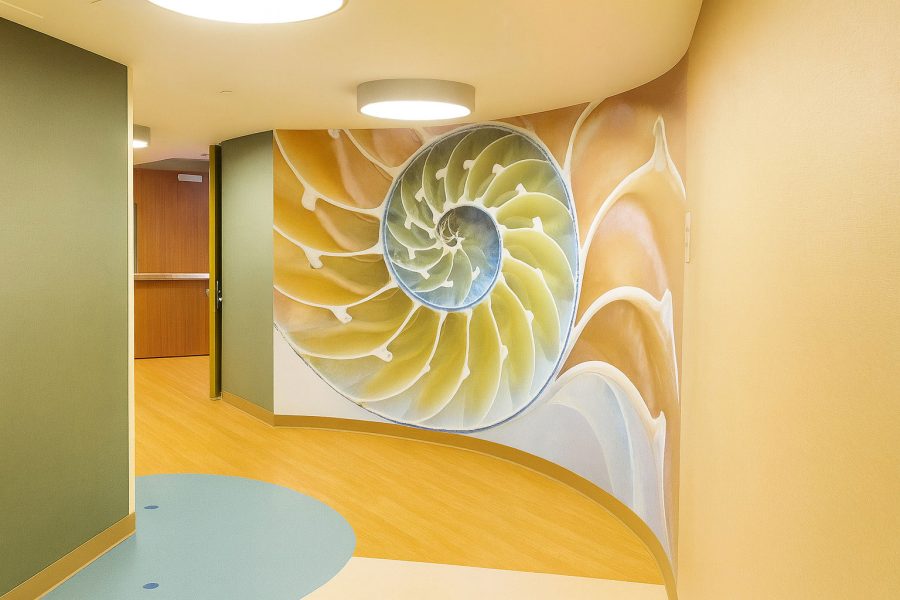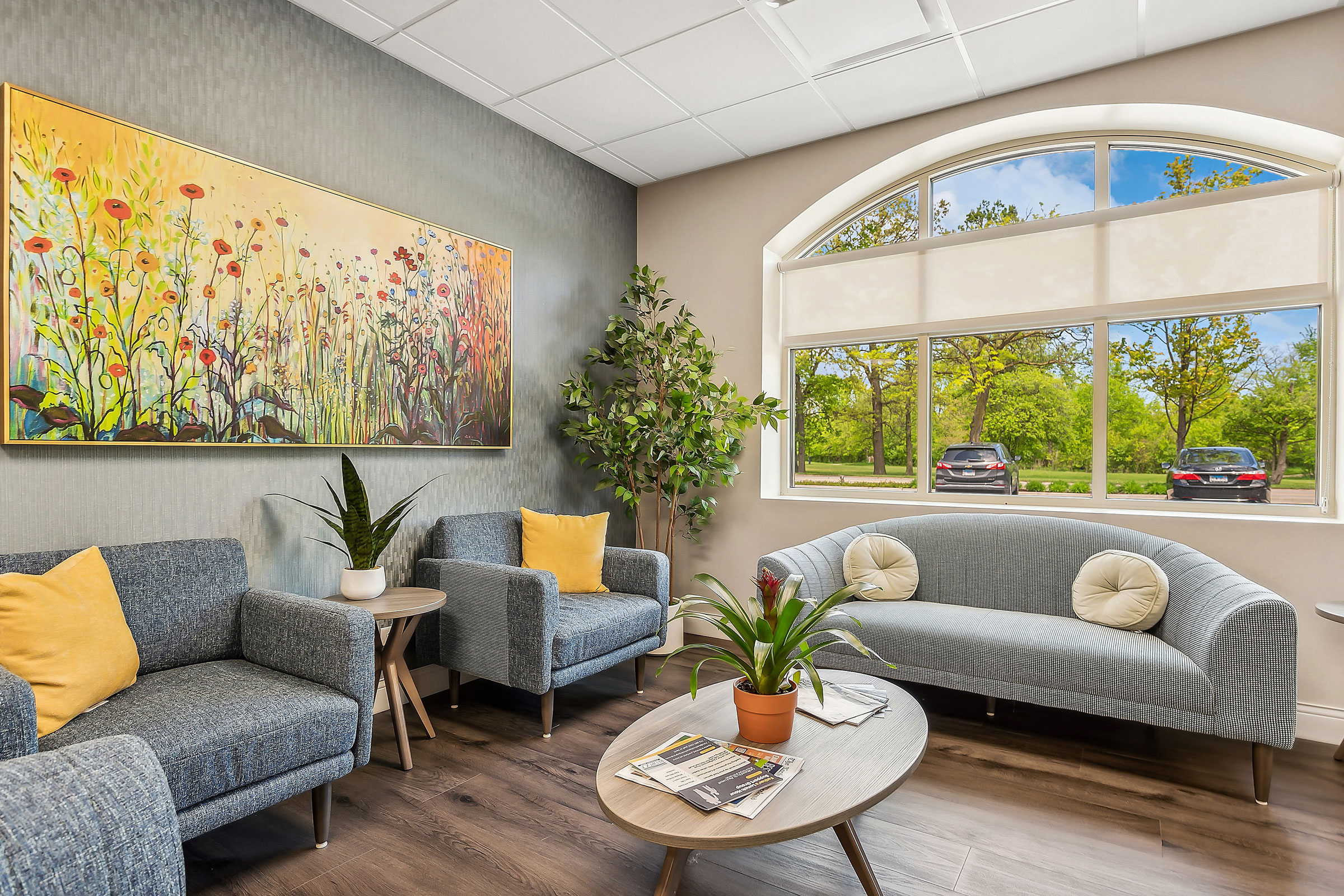Story at a glance:
- Nature-inspired imagery remains foundational, but hospitals are increasingly embracing bold, playful, and non-traditional art.
- Art isn’t just aesthetic; it improves orientation, reduces stress, and makes spaces feel more human.
- The future of health care design is expected to borrow from hospitality, emphasizing welcoming spaces for staff, visitors, and community connection while supporting both patients and caregivers.
Humans have used art as a tool of expression and healing for millennia. But it wasn’t until the mid-20th century that the concept of “art therapy” hit the zeitgeist, when British artist Adrian Hill used painting to expedite his recovery from tuberculosis. In the years since, art therapy has been incorporated into hospitals worldwide—and its next iteration could shape health care design from the ground up.
“Art therapy programs have long been shown to aid recovery, but now the trend is to expand it into the design of the facility itself. We’re stepping away from a sterile, sanitized look and thinking about art as a part of the recovery process,” says Clémence Mailly, a senior art advisor for MDC Art, a division of MDC Interior Solutions.
Nature & Beyond

MDC Art offers a turnkey art consultancy that manages every aspect of the art process from concept to installation, ensuring seamless integration. Photo courtesy of MDC Interior Solutions
For decades nature has served as the foundation for health care art. Soft landscapes, local photography, and biophilic patterns reliably reduce stress and create a sense of familiarity, but Mailly says the palette is broadening.
“Health care art has evolved far beyond just calming landscapes,” she says. “More and more clients are asking for bold, vibrant pieces, murals, or sculptural installations that bring energy and joy into the space.”
Art can also be used to spark hope, foster motivation, and strengthen a sense of connection for patients and families, she says.
Getting Practical
Beyond bringing beauty into a space, art and finishes can also serve many practical purposes. Emma Leach, an associate interior designer with 10 years of experience at Stantec, tends to use them as “intuitive wayfinding” tools, implementing finishes that subtly guide patients and caregivers through a health care building.
Leach may use warm wood tones at the check-in desk and public elevators to help subtly guide visitors to these areas, for example. Design touches like these can help reduce additional stress during already overwhelming visits, she says.
Art and design are merging into one immersive experience.
Art installations can also help break up large hospital rooms into cozier and more welcoming zones. When redesigning the UPMC Children’s Unit in Harrisburg, Pennsylvania, Leach and the Stantec team used park-inspired dividers to create distinct areas for washing up, crafting, and relaxing with visitors.
Art and finishes can also help prompt relaxation during procedures or tests. For certain projects Leach has placed nature-inspired, biophilic installations on the ceiling of imaging rooms to serve as positive distractions for patients on stretchers.
Mailly says the most successful health care projects integrate art (in all its many functions) from the very beginning. Her team at MDC Art is increasingly brought on before construction begins on new projects. “We collaborate with interior designers, architects, and decision-makers from the ground up. Engaging early helps us coordinate art with everything in the space,” she says. “Art and design are merging into one immersive experience.”
Taken together these approaches reflect a growing body of evidence—art can reduce anxiety, improve orientation, and make health care spaces more supportive for both patients and staff.
Special Considerations
- Photo courtesy of Leftbank Art, MDC Art
- Photo courtesy of MDC Interior Solutions
Health care design presents a few unique challenges: Art and finishes need to withstand high foot traffic, be easy to clean, and remain stable and durable for the long haul. Sealed, nonporous surfaces are a must, as are timeless and enduring motifs.
The art should also be chosen with patient populations in mind. Mailly says pediatric settings may call for more colorful, playful, and interactive visuals, while behavioral health projects require “softer, trauma-informed imagery and safety-first framing.”
She avoids visuals that may be disorienting, like blurry images or high-contrast patterns, as well as colors known to heighten stress responses, like bright reds, or imagery with unintended symbolic associations, like sunsets, which could evoke feelings of loneliness or the end of life.
We’re stepping away from a sterile, sanitized look and thinking about art as a part of the recovery process.
Instead the MDC Art team focuses on calming yet engaging pieces that feel timeless while reflecting the surrounding community when possible. “A lot of hospitals and health care facilities are asking for collections that reflect their region, whether that’s commissioning local artists or featuring recognizable landscapes and natural environments,” Mailly says.
Each piece is intentionally chosen to fit with the design of the project as a whole, reinforcing the broader environment rather than feeling like an afterthought. That regional focus not only supports local culture but also helps patients feel grounded and familiar in otherwise stressful environments, she says.
Looking Ahead
Experts predict amenity spaces will continue to feature more prominently in health care design in the future, with a focus on visitor lounges, staff respite areas, and cultural connections woven into design. “There will be a lot more focus not only on the patient experience but the overall experience for visitors, staff, or anybody experiencing the building,” Leach says.
Mailly expects health care spaces to feel increasingly like hospitality environments, complete with welcoming, community-supported spaces.
What’s unlikely to change? The need for safe, durable finishes paired with art that makes the often overwhelming experience of a hospital visit feel more manageable.
“Our program is not just decorating a building,” Mailly says. “It’s really helping define the environment, support healing, and build a cohesive experience.”



